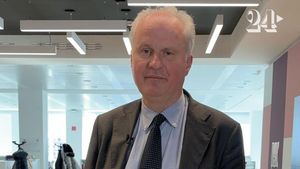On February 5, 2025, Prime Minister Narendra Modi made his way to Prayagraj to partake in the Maha Kumbh Mela, one of the largest religious gatherings globally, where he observed the ceremonial ritual of taking a holy dip at the revered Triveni Sangam—the confluence of the rivers Ganga, Yamuna, and the mythical Saraswati. Accompanied by Uttar Pradesh Chief Minister Yogi Adityanath, the Prime Minister arrived around 10 AM and donned traditional attire for the auspicious occasion.
Upon reaching the Mela, PM Modi took a boat ride from Arail Ghat to the Sangam, immersing himself deeply not only physically but spiritually. Clad in saffron attire, including a full-sleeve deep orange jersey and blue lowers, he held rudraksha beads tightly as mantras flowed from his lips. It was not just another ritual but rather, as he later expressed, "a moment of divine connection". The Prime Minister shared on social media, "Today, I got the great fortune of performing Puja-Archana after bathing in the holy Sangam at Prayagraj Maha Kumbh. I got immense peace and satisfaction from the blessings of Maa Ganga. I prayed to her for the happiness, prosperity, health and well-being of all the countrymen. Har-Har Gange!"
The Maha Kumbh Mela, which started on January 13, 2025, and will conclude on February 26, is touted as the world’s largest festival, drawing millions of pilgrims and devotees from across the globe. The event is characterized by its massive crowds, deep-rooted traditions, and communal spirituality. By early morning on the same day of PM Modi's visit, reports indicated over 3.748 million devotees had already taken the holy dip, enhancing the atmosphere of devotion surrounding the festivities.
Uttar Pradesh’s Chief Minister Yogi Adityanath, who has been actively promoting the event, emphasized its significance by sharing insights about the unity among pilgrims, referring to Hindus and Buddhists as branches of the same banyan tree. He noted, "Our unity will create the strongest foundation for peace and protection worldwide," reflecting the event's broader significance beyond personal faith.
Security measures were noticeably heightened to accommodate the large influx of attendees at the Maha Kumbh. With over 37,000 police personnel deployed, various forces including PAC, CRPF, BSF, and CISF worked cohesively to manage the crowds and maintain order during this significant religious gathering.
Aside from security, logistics were equally prioritized; the Prayagraj railway division set up 106 Mela special trains alongside 200 regular trains, ensuring safe passage for lakhs of devotees visiting during Basant Panchami.
Highlighting the national significance of the Maha Kumbh, Union Minister Kiren Rijiju, who also took part in the holy dip, eloquently urged against politicizing the sacred occasion. He stated, "Maha Kumbh occurs once in 144 years, spanning multiple generations. No one should indulge in politics over such a sacred and historic event. I feel fortunate to have taken part in this moment."
The participation of high-profile individuals throughout the Maha Kumbh, including notable politicians and even global celebrities like Bhutan's King Jigme Khesar Namgyal Wangchuk, demonstrates the festival's importance across various demographics. King Wangchuk participated actively, engaging with local customs and rituals during his visit, which highlights the event’s diversified appeal.
While PM Modi participated prominently, crowds and pilgrims of various backgrounds filled the banks of the Sangam, creating an inclusive atmosphere commonly associated with the Kumbh. Various preparations took shape including accommodations for senior citizens and initiatives aimed at ensuring hygiene and sanitation. This was led by campaigns like Shravan Kumbh, which served thousands, promoting environmental cleanliness and responsible conduct among visitors.
Overall, Prime Minister Modi’s visit during the Maha Kumbh has reinforced its significance as not merely a religious event, but as an emblem of cultural heritage, unity, and national pride. His shared experiences with fellow devotees captured the essence of spirituality permeated by contemporary concerns, making the event resonate deeply with millions across India.
This grand celebration which occurs every 12 years, has reinforced the idea of faith and devotion, transcending social divides and echoing the ethos of Indian culture.



